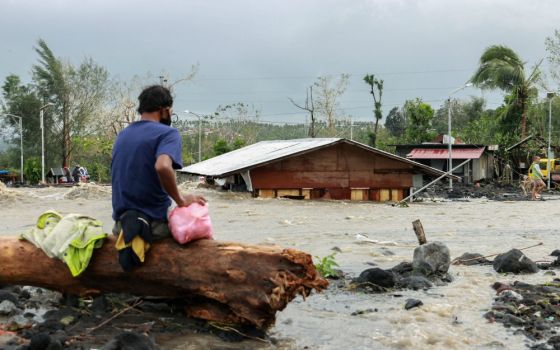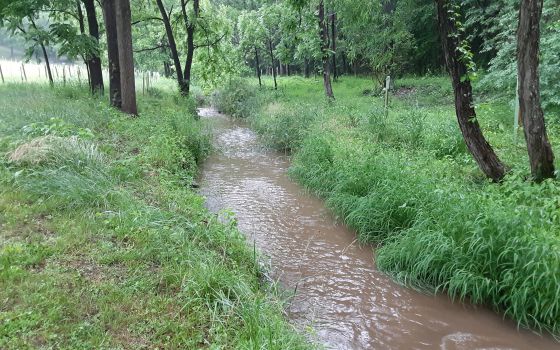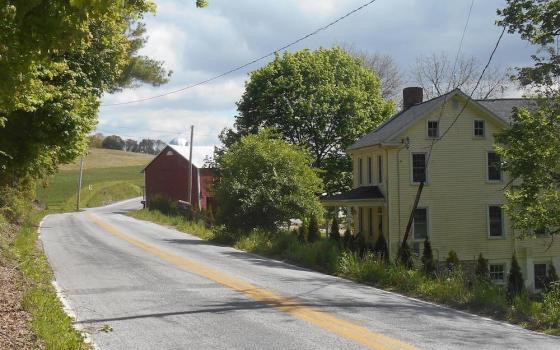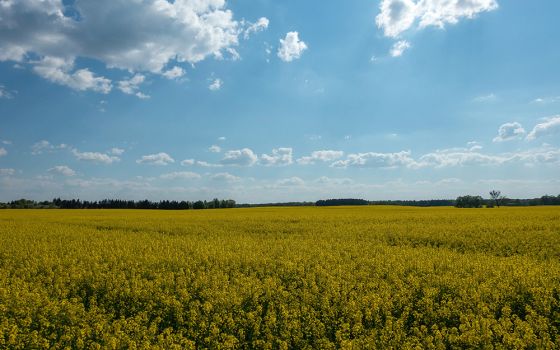There was a time when Br. Jaazeal Jakosalem had little success when he asked bishops in the Philippines to join campaigns against mining or coal-fired power plants endangering communities as well as the land.
It wasn't that the bishops were ignoring the issues facing the environment — they'd written a half-dozen statements on the topic since the late 1980s. They just weren't as visible in the struggle to do something about them, said Jakosalem, a lifelong environmental activist and a member of the Order of Augustinian Recollects.

Br. Jaazeal Jakosalem, aka Brother Tagoy, joins a direct action against a coal plant in Toledo City, Cebu, Philippines. (Provided photo)
The Philippines is one of the world's front lines on climate change. Last week, Typhoon Vongfong slammed into the Eastern Samar province, forcing the evacuation of hundreds of thousands of people in a region that seven years earlier was decimated by Typhoon Haiyan. Climate scientists expect such tropical storms to become more powerful and more frequent as global temperatures rise.
Things have changed in the post-Laudato Si' world.
Today, the Catholic Church of the Philippines is seen as one of the leaders in answering the call that Pope Francis issued to the entire world in his 2015 social encyclical, "Laudato Si', on Care for Our Common Home."
Since the encyclical's release, Jakosalem, better known as Brother Tagoy, says more bishops have joined him and other religious in speaking out against the construction of new coal-fired power plants and the damaging effects of mining on both communities and the land. Last July, the Philippine bishops conference issued a pastoral letter on the "climate emergency," calling the full church on the islands to an ecological conversion and to "activate climate action on behalf of the voiceless people and the planet."
"They are emboldened to act more for the caring of our environment," Jakosalem told EarthBeat in a phone interview.
Five years after the publication of Laudato Si', you can easily find such examples across the world of individual Catholics, parishes and institutions responding to the pope's own repeated appeal for ecological conversion with prayer and reflection over the encyclical but also with concrete actions in living it out.
Even with those examples, the consensus among Catholic ecological leaders is those responses have been not nearly as widespread as Francis sought with his universal call "for a new dialogue about how we are shaping the future of our planet." Count the pope among them.
'When we pass that 1.5 degrees threshold, climate change will move into all of our living rooms.'
—Veerabhadran Ramanathan
"Sadly, the urgency of this ecological conversion seems not to have been grasped by international politics, where the response to the problems raised by global issues such as climate change remains very weak and a source of grave concern," Francis said in January in remarks to the Vatican diplomatic corps.
The call for increasingly urgent action from a historically slow-moving institution is driven by awareness of the numerous crises facing the planet.
The coronavirus pandemic struck at the start of a decade that climate scientists say is critical to reduce greenhouse gas emissions. Doing so would prevent the most severe consequences of climate change, which threatens to exacerbate poverty, hunger, lack of water access, and migration, all impacting first and fiercest the world's already most vulnerable communities.
Already, global temperatures have risen 1 degree Celsius (1.8 degrees Fahrenheit) since the late 1800s. The planet is on pace to warm another 2 degrees C by the end of the century, and to reach the critical 1.5-degree mark as soon as 2030. Roughly 20% of the planet already has, according to a Pulitzer-winning report by The Washington Post.
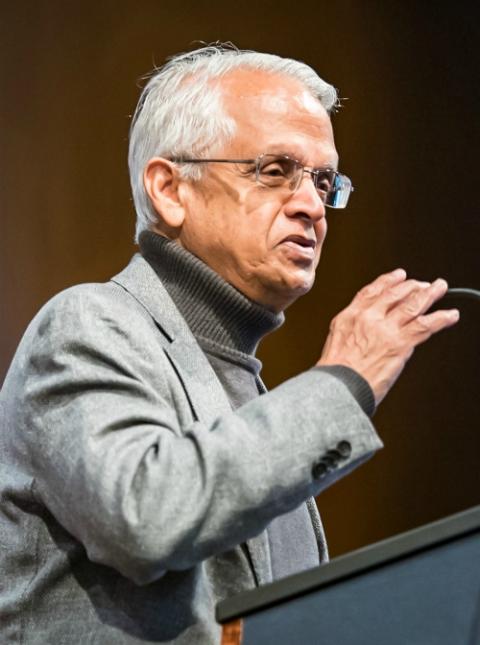
Veerabhadran Ramanathan speaks on solutions to climate change during a 2018 lecture at Villanova University in Philadelphia. (CNS/Courtesy of Villanova University/Paul Crane)
"When we pass that 1.5 degrees threshold, climate change will move into all of our living rooms," said Veerabhadran Ramanathan, a climate scientist at the Scripps Institution of Oceanography at the University of California San Diego and member of the Pontifical Academy of Sciences. "You don't have to turn on TV to find out about climate change."
The pandemic has some worried it may slow momentum for addressing climate change. But there is also optimism up to the highest levels of the Catholic Church that how the world responds, economically and otherwise, just may be the multitrillion-dollar stimulus needed to jumpstart the globe to match societal actions with the urgency of the science.
And perhaps Laudato Si' can play a part.
"Laudato Si' has an immense amount of wisdom to charter that path and just aid us in that journey," said Tomás Insua, co-founder and executive director of the Global Catholic Climate Movement.
Responding on a global scale
Some of the biggest impacts from Laudato Si' so far are found in what's formed from it.
Take the Global Catholic Climate Movement.
When it launched in January 2015 during Francis' papal trip to the Philippines — where he visited communities devastated by Typhoon Haiyan — it had 19 members, a mix of church development agencies, religious orders and Catholic environmental groups. In five years, it has grown to more than 900 organizations, representing every continent and more than 50 countries.
'We feel included in this call of Laudato Si'.'
—Domenica Reyes
The movement, often called GCCM by members, has spearheaded some of the more prominent responses to living out Laudato Si', and all at a global scale. Months after forming, it generated 900,000 signatures onto a Catholic Climate Petition delivered to world leaders at the COP 21 climate summit in Paris. It has trained more than 2,800 Laudato Si' Animators, who are tasked with doing just as their name implies in their local communities. Another 5,000 are in training now.
Each Lent, GCCM has organized creation-centered programs. Through its divest-invest campaign, it has played a leading role in facilitating more than 180 Catholic institutions to publicly declare they will cease investments in the fossil fuel industry.
At World Youth Day 2019 in Panama, GCCM formed a youth branch called Laudato Si' Generation. The group, now at 1,200 members worldwide, has brought a faith-based presence to the youth climate strikes.
Domenica Reyes, co-chair of Laudato Si' Generation, said young Catholics see in Laudato Si' a symbiosis between their faith and their concern for the environment. It's become "a spark," she added, empowering them to get involved and to press their politicians and priests alike to make environmental issues a priority.
"We feel included in this call of Laudato Si'," she said.
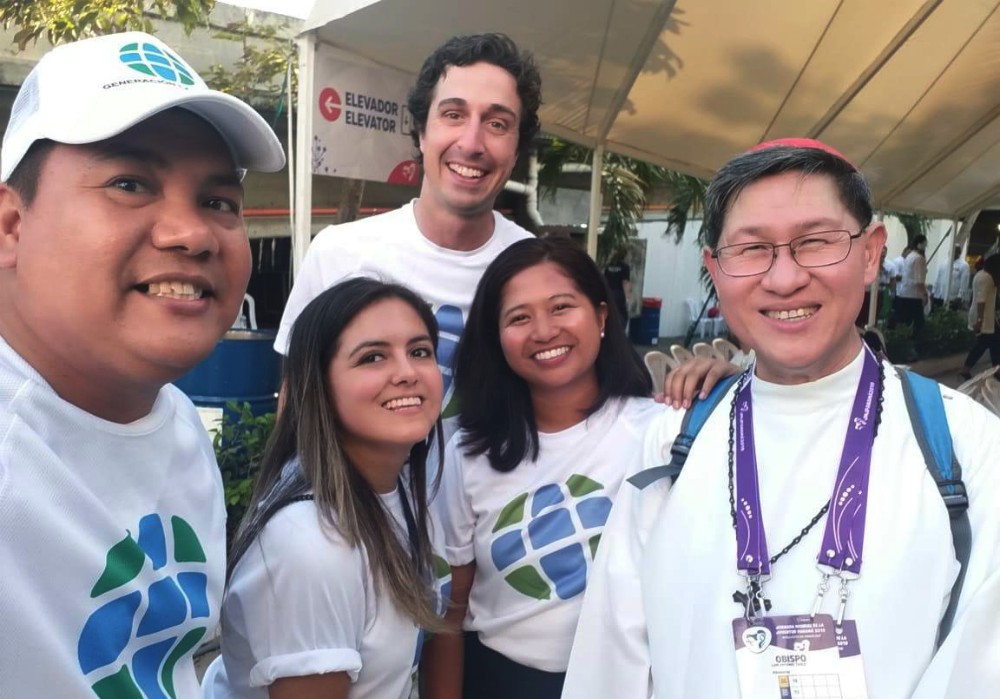
Members of Laudato Si' Generation pose with Cardinal Luis Tagle, then archbishop of Manila, Philippines, during World Youth Day in Panama City in 2019. Second from left is Domenica Reyes, co-chair of Laudato Si' Generation, and in center is Tomás Insua, executive director of Global Catholic Climate Movement. (Global Catholic Climate Movement)
One of the biggest initiatives around the encyclical to date has been the Sowing Hope for the Planet project, a campaign orchestrated by the International Union of Superiors General, an umbrella group representing 2,000 women religious congregations. A network of 980 contacts share information and resources with their congregations to promote Laudato Si', and in particular its message of answering both "the cry of the earth and the cry of the poor." Sowing Hope for the Planet, for which GCCM is a collaborator, has seen Catholic sisters in the U.S. and Ghana partner in a plastic recycling program that reduces waste and provides jobs, and the Servants of the Holy Spirit Sisters work with other nongovernmental organizations to stop mining in Timor West.
Franciscan Sr. Sheila Kinsey, coordinator of Sowing Hope and UISG executive co-secretary of the justice, peace and integrity of creation commission, said the encyclical is clear, inspiring and practical. Now it's up to the wider church to pursue the systematic change it says is necessary.
"We must make a clear connection between our spiritual values and our daily actions," she said.
GCCM also played a role in the creation of the Laudato Si' Action Platform, announced at the start of Laudato Si' Week (May 16-24) by the Vatican Dicastery for Promoting Integral Human Development. The platform invites Catholic institutions to commit to "total sustainability" within a seven-year period through an integral ecological approach.
The goals are an invitation, not a mandate. The dicastery hopes that ground-up approach will yield a "critical mass" sweeping through the church that so far has yet to fully materialize.
"If I'm totally honest, it still often feels like we're at the very beginning," said Lorna Gold.
Gold has had a unique vantage point to the response to Laudato Si'. Until recently, she worked with Trocaire, the Irish Catholic development agency, and served on the Irish bishops' Laudato Si' Working Group. She is a GCCM board member. She has also been active in the climate strikes and is the author of Climate Generation: Awakening to Our Children's Future.
Asked to grade the global church's implementation so far, Insua responded, "It's low. A low grade." But that grade is a mixed bag, he said, with Amazonian countries and the Philippines at the high end, and the United States and Europe on the lower side.
Advertisement
"Encyclicals take time to sink in. A lot of time," Insua said. "But that's the problem with this encyclical, is that it doesn't allow for a lot of time to be taking on."
Along with the action platform, expected to launch in early 2021, the Vatican has introduced other prompts to spur action throughout the church.
Francis has recommended care for our common home be added to both the corporal and spiritual works of mercy. Following other Christian denominations, he added a World Day of Prayer for the Care of Creation (Sept. 1) to the liturgical calendar, and invited Catholics to celebrate the Season of Creation throughout September to Oct. 4, the feast of St. Francis of Assisi.
The Vatican delegation has been active at the United Nations climate summits, with the encyclical viewed as a factor in reaching the Paris Agreement.
Back home, the Vatican has hosted numerous conferences of scientists, economists and world leaders. The past two years, it held meetings with top oil executives and investment firms, where Francis called for "a radical energy transition" to stave off "a climate emergency." The 2019 session resulted in nearly all participants signing a declaration in favor of a price on carbon emissions and increased transparency from energy companies.
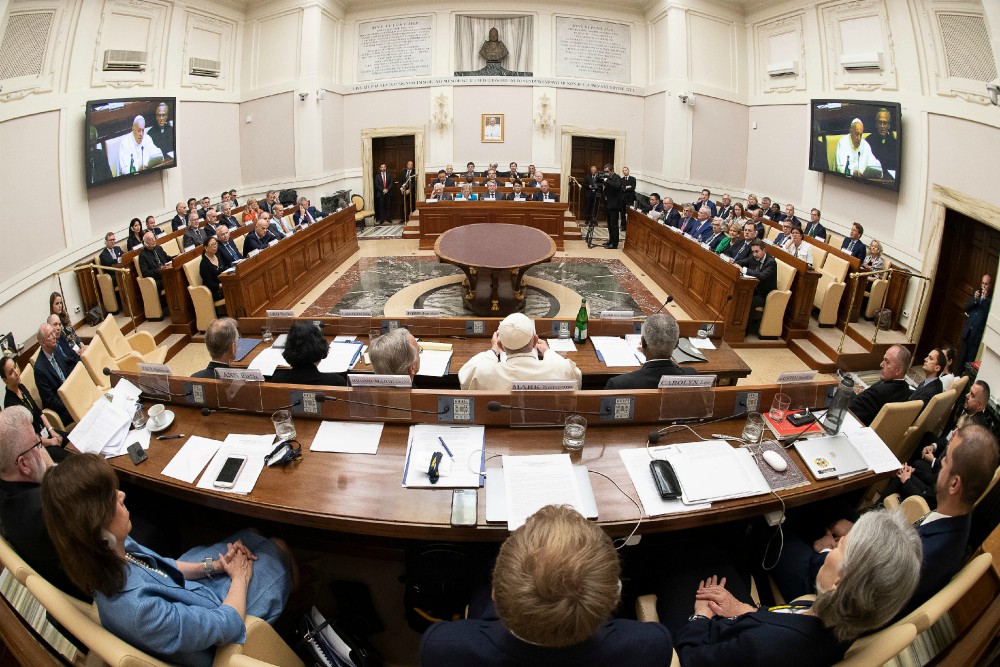
Pope Francis speaks to executives of leading energy, petroleum and natural gas companies, leaders in investment firms and climate scientists during a meeting at the Vatican June 14, 2019. (CNS/Vatican Media)
Insua singled out the Season of Creation as perhaps the most significant church response to the encyclical in the past five years. He said it gives Catholics and parishes not just a day but an entire month each year to plan programs reflecting on their place within their environment and how to preserve it.
"In a lot of people's minds, slowly but steadily, September is that time of the year," he said.
The difference leadership makes
The Season of Creation wasn't so new to Philippine Catholics. By 2003, Catholics there had begun celebrating in September its own creation time.
In many ways, the encyclical has reinforced throughout the archipelago ecological ministries in place for decades and has energized more to take part.
Jakosalem, 47, said Laudato Si' has been an affirmation of their work by placing creation care squarely in the framework of church teaching. Likewise, it's bolstered more bishops and priests to take prophetic stands against extractive industries without worrying what the financial repercussions to the church may be.
"We feel secured because of this document," he said.
In September, the Philippine bishops pledged to divest from fossil fuels. Their climate emergency pastoral called each diocese to establish ecology desks to spearhead programs pressing for a swift and just transition to clean energy, organizing to pass and implement environmental protection laws, and critically, integrating Laudato Si' and creation care more fully into church teaching in parishes, schools and seminaries.

Archbishop José Palma of Cebu, Philippines, speaks during an event for the Break Free from Coal campaign. (Jaazeal Jakosalem)
Archbishop José Palma of Cebu was instrumental in the campaign to block a new coal plant on the island. The four bishops of Negros Island have been active in efforts to block new coal-fired power plants. In both cases, the projects were not approved.
"This is something, huh?" Jakosalem said.
Like the Philippines, the bishops in Ireland established a Laudato Si' working group early on. Gold, one of its members, said it played a major role in bringing regular proposals to the bishops' conference and ultimately making Laudato Si' a higher priority on their agenda.
One result was the Irish bishops' decision to divest from fossil fuels, announced in August 2018 ahead of Francis' visit as part of the World Meeting of Families. Individual dioceses and religious orders have followed suit. Trocaire played a critical role in the Irish government's own decision to divest. The Irish bishops have also committed to the Season of Creation.
Gold said one ongoing priority is making Laudato Si' part of the formation of clergy and church leadership. Trocaire found some success through trips, at home or overseas, to witness climate injustices up close. Bringing priests and bishops more on board doesn't mean they do all the work, she added, but they are uniquely positioned to deliver the message and set in motion wider action in conserving God's creation.
"To reach a certain scale it really has to be about working alongside and working with the bishops' conference," Gold said.
What difference leadership can make is evident in the Amazon.
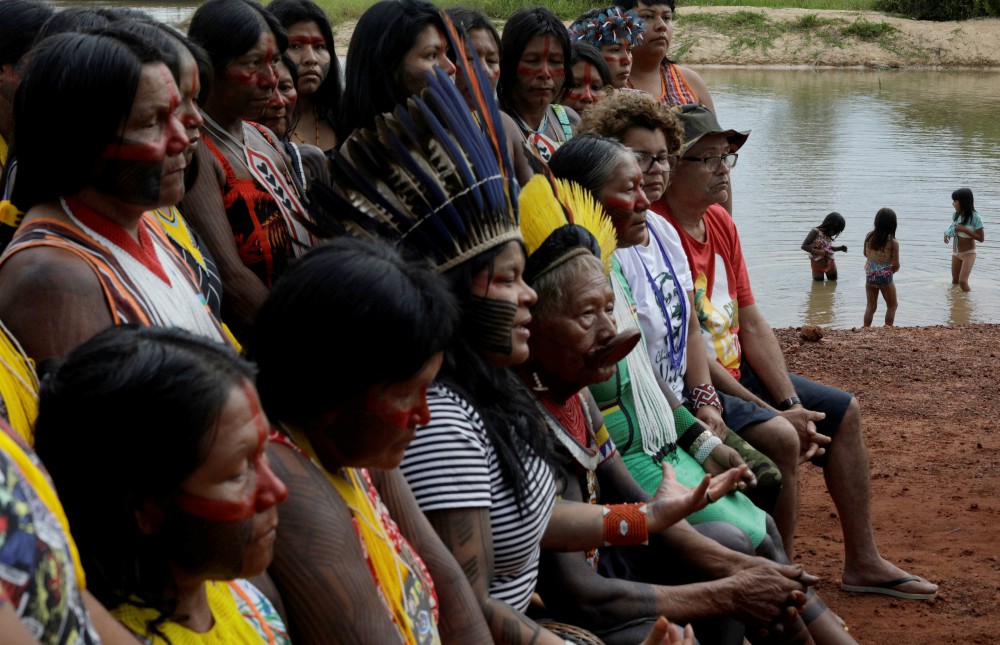
Indigenous people are seen on the banks of the Xingu River during a media event in Brazil's Xingu Indigenous Park Jan. 15, 2020. (CNS/Reuters/Ricardo Moraes)
Over the course of two years, bishops through the Pan-Amazon Ecclesial Network conducted 260 listening sessions across the nine Amazon countries on the threats facing one of the world's most biodiverse and critical ecosystems. All that culminated in October with the Vatican's special Synod of Bishops for the Amazon, what many viewed as the first major application of Laudato Si'.
The vast majority of participants hailed from the Amazon Basin, and included bishops, priests, religious and indigenous leaders. The synod turned the global church's attention to the multiple crises — like deforestation, mining, biodiversity loss and land disputes — facing the Amazon, a key region in mitigating climate change. Raging fires in the rainforest in the preceding months highlighted the situation.
The synod's final document and Francis' own reflection, Querida Amazonia, positioned the church shoulder to shoulder with indigenous communities in defense of their rights and protecting the rainforest against destructive, unrestrained industrial development.
In the final document, the participants identified climate change as "above all" the great threat to life in the region. They proposed a definition of ecological sin and called on all Christians to defend human rights in the Amazon as "a requirement of faith." They recommended creating environmental awareness training programs and special ministers, and for the church in the Amazon to support and join divestment campaigns of industries causing socio-ecological damage.
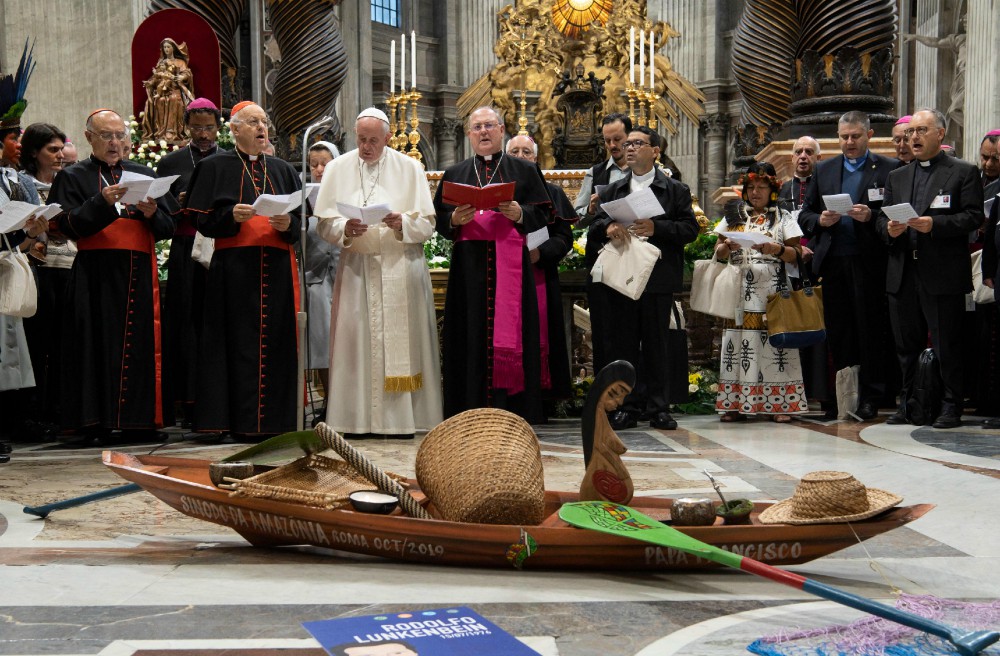
Pope Francis attends a prayer service at the start of the first session Synod of Bishops for the Amazon at the Vatican Oct. 7, 2019. (CNS/Vatican Media)
Reyes, the Laudato Si' Generation co-chair based in Ecuador, said one of the biggest contributions of the encyclical, reinforced by Querida Amazonia, is in the awareness it's raised on how everything is connected. That protecting the Amazon doesn't matter just for people living there, but for the future of the entire world.
"That Amazon is not only a matter of the Ecuadorian or Brazil church, but it's a matter of the universal church," she said.
US response 'still a work in progress'
In the United States, the prevailing sense among Catholics working on environmental issues is Laudato Si' has not been made a main priority.
Outgoing president Cardinal Daniel DiNardo made waves at the November meeting of the U.S. Conference of Catholic Bishops, when he described the sense among bishops about global warming as important but not urgent.
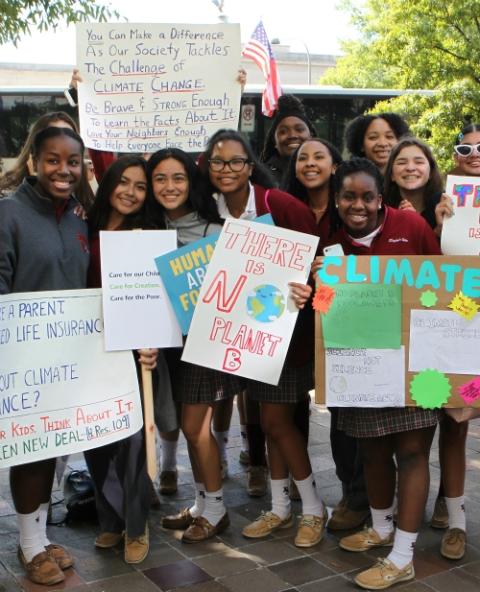
Juniors and seniors from environmental science classes at Elizabeth Seton High School, a girls school in Bladensburg, Maryland, stand with their climate change signs along Constitution Avenue in Washington Sept. 20, 2019, as they prepare to join a march with thousands of others to the front of the U.S. Capitol. (CNS/Carol Zimmermann)
The comment was widely seen as at odds not only with the science but with the pope. Within the encyclical's introductory appeal alone, Francis stated the urgency three times — and more than a dozen in total, including the "urgent need" to develop emissions-reducing policies "in the next few years." He has repeated that urgent message in nearly every speech on the topic since.
During an online roundtable May 20, three U.S. bishops acknowledged uneven response so far. "It's still a work in progress," conceded Archbishop Paul Coakley, chair of the bishops' Committee on Domestic Justice and Human Development.
San Diego Bishop Robert McElroy, a leading U.S. voice on the encyclical, said that while it's been well-received by scientists and the young, he worries the church has yet to reach the intensity that climate change requires.
"We don't have 40 years left on the climate question," McElroy said in response to comments from Los Angeles Auxiliary Bishop Robert Barron that past encyclicals took decades to be put in practice.
Last summer, the Catholic Climate Covenant held the first of three biennial conferences at Creighton University in Omaha, Nebraska, aimed at ramping up implementation in the U.S. church.
In an op-ed last month, Dan Misleh, Covenant executive director, reflected on progress at the five-year mark: "If I'm honest, not nearly to the degree I would have hoped nor commensurate with the scope of the challenge we are facing."
Franciscan Sr. Joan Brown is among the many who point to a lack of leadership.
Women religious congregations like hers have long been at the forefront of environmental action. Universities and schools have increasingly emphasized sustainability in recent decades. But for the church to take the next big leap will require the ecological conversion taking root with more priests and bishops, said Brown, who is executive director of New Mexico Interfaith Power & Light.

A line of protesters Aug. 18, 2015, blocks the main gate at the Crestwood Midstream Partners gas storage facility on the shores of Seneca Lake in Reading, New York. Eighteen people were arrested while reading Pope Francis' encyclical Laudato Si'. (CNS/Dennis Sadowski)
A first step, she suggested, is viewing climate change through integral ecology, that issues related to the environment, poverty, inequality, immigration and life are all interrelated.
"There has to be some deep-seeded shifts in the church for us to really grapple with this largest ethical and moral concern of our time," Brown said. "And the longer it takes us, the more we run into greater storms, greater need for emergency relief."
In speaking at churches, the climate scientist Ramanathan said he's surprised by the number of Catholics who haven't read Laudato Si' or aren't aware of it. Educating more people about the text — what he calls "a singular iconic document" that spells out the human tragedy of climate change — and the climate science is essential, he said, to garnering wider support for the solutions, stressing "there is still time for solving the problems."
Laudato Si' "is a powerful tool that Pope Francis has put in our hands and we have to use it," Ramanathan said.
'Let's face it, the most convincing way that the document will be put into practice is if people can see a direct impact on their own lives.'
—Archbishop Wilton Gregory
Within the U.S. bishops' conference, policy work has been a major focus, said environmental policy consultant Ricardo Simmonds. The conference has issued dozens of statements citing Laudato Si' — during the Obama administration in support of environmental measures and during the Trump years opposing rollbacks and deregulation.
Simmonds agrees that there's much more that can be done, but from his view he sees a lot happening already. The U.S. bishops were official partners for the Vatican's Laudato Si' Week and produced resources for parishes and priests. Later this summer, the conference plans to start its own Laudato Si' advocates program geared toward young Catholics.
So far, the bishops' conference hasn't discussed establishing a Laudato Si' commission like those in other countries, Simmonds said. At the Creighton conference, McElroy suggested the idea as a way to make climate change "a central priority" in the U.S. church.

Washington Archbishop Wilton Gregory at the Oct. 17, 2019, blessing of solar panels that are being leased to produce renewable energy for Washington residents (CNS/Catholic Standard/Andrew Biraj)
Washington Archbishop Wilton Gregory, seen as another Laudato Si' leader, told EarthBeat he would support forming a working group, but that it may be more effective at a regional level "because the environment, while it belongs to all of us, manifests itself with great regional diversity," he said in a phone interview.
While archbishop of Atlanta, Gregory commissioned a Laudato Si' Action Plan to bring the text to life across all church levels. The plan has become a blueprint for other dioceses, and he has asked the D.C. archdiocese's care for creation committee to devise its own version. In April, Catholic Charities of Washington Archdiocese completed construction of a 2-megawatt solar array — the largest solar installation in the District.
The solar project was facilitated by Catholic Energies, a program of Catholic Climate Covenant. Since it formed in fall 2017, it has completed 10 projects in five states, with another 12 set for construction this year. Together, they will generate 10 megawatts of solar energy annually, the equivalent of removing 5 million pounds of carbon emissions from the atmosphere.
The adoption of solar by parishes and dioceses has been one of the most visible responses to Laudato Si' in the U.S., with the dioceses of Monterey and San Diego in California leading the pack. The Diocese of Richmond, Virginia, has seven parishes signed up with Catholic Energies and is looking to develop a 5-7 megawatt array at a retreat center.
Apart from energy projects, the Cincinnati Archdiocese has a creation care task force, while the Diocese of Arlington, Virginia, formed a network linking its parish green teams. In 2017, the statewide Diocese of Burlington, Vermont, celebrated a Year of Creation. Last year, the California bishops issued a pastoral statement responding to Laudato Si' and outlining specific steps to implement it locally. A now-permanent creation care committee will guide its rollout. A similar statement was issued by the Minnesota Catholic Conference.

Technician Brian Wayson of AirStream Mechanical in Cincinnati checks wiring on a high-efficiency air conditioning unit at St. John Fisher Church in Newtown, Ohio, Aug. 17, 2017. Retrofitting the unit was one part of a continuing effort under the Catholic Energies program to help Catholic facilities and other entities reduce energy consumption. (CNS/Dennis Sadowski)
Gregory told EarthBeat he plans to meet with priests in the next week about ways for parishes to more actively implement the encyclical. Part of that will be giving examples of what works, what he said is one of the most important uses of his role.
"Let's face it, the most convincing way that the document will be put into practice is if people can see a direct impact on their own lives," the archbishop said.
'Climate change in a time warp'
The collision of the coronavirus pandemic with rising global temperatures has many people calling for solutions that will address both.
During a Laudato Si' Week discussion May 18, Fr. Augusto Zampini, co-secretary of the Integral Human Development dicastery, echoed the pope that the economic response to the pandemic should be reframed from a recovery to a regeneration.
"If recovery means going back to what we were before, I'm sorry, we don't want that," he said. To care for creation or to achieve the U.N. Sustainable Development Goals, he said, means "we necessarily need to change the current economic development model. It's incompatible if we continue growth that is based on destroying our source of life."
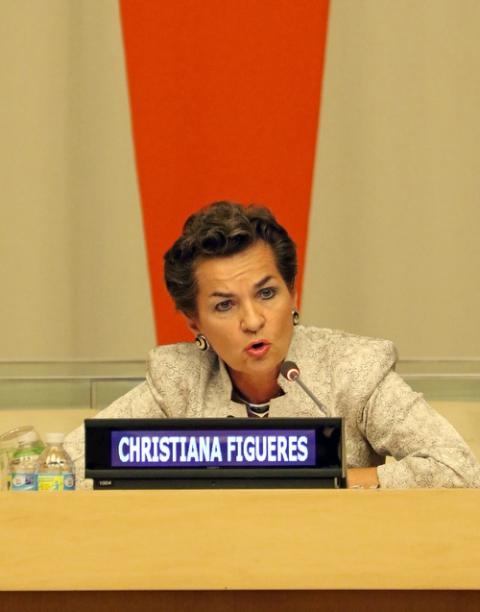
Christiana Figueres addresses the audience during a presentation on Pope Francis' encyclical on the environment June 30, 2015, at U.N. headquarters in New York City. (CNS/Gregory A. Shemitz)
Christiana Figueres, former U.N. climate chief, called the pandemic "climate change in a time warp," offering a preview of what temperature rise above 1.5 degrees C would bring. She said the pandemic shows that big changes are possible, and that the next 18 months will be critical, as governments inject trillions of dollars into economies, for bending the climate curve and determining what values will take priority going forward.
"It is an unprecedented opportunity to press the reset button," Figueres said. "To prove that we have learned from our mistakes of the past. To prove that in reflection of who we really are and of our creator that we can actually act with much more responsibility, with much more solidarity and with much longer vision. And that we are entirely capable of making decisions to build back better."
The Vatican's COVID-19 commission has been developing recommendations for ways to make that new world possible.
Along with that work, the Laudato Si' Action Platform and related goals were framed in the context of the pandemic: "We have, in fact, a unique opportunity to transform the present groaning and travail into the birth pangs of a new way of living together, bonded together in love, compassion and solidarity, and a more harmonious relationship with the natural world, our common home."
The World Resources Institute has consulted with the integral human development department on the action platform. It has recommended ways to practically implement the encyclical's approach of integral ecology and addressing both "the cry of the Earth and the cry of the poor."
In that frame, each goal is equally important, said Esben Larsen, a fellow with World Resources Institute and member of the Vatican's COVID-19 task force. That said, he and others see great potential in leveraging the global church's institutions and land holdings to make major impact in such areas as energy, food waste and clean water access.
"Just imagine the 8% of land [globally] owned by the Catholic Church, if you have programs increasing biodiversity, land restoration, fighting deforestation. This can be massive," Larsen said.
The climate scientist Ramanathan sees the two major contributions the church can make this decade as reducing its own emissions and influencing public opinion on climate change by using its educational institutions to spotlight the need for urgent, transformational change.
"I don't think any other religious institution has the reach as the Catholic Church and its amazing educational institutions. Laudato Si' gives it an unparalleled opening to undertake this task," he said.
The action platform maps a path forward that many Catholics working on climate have wanted the church to take. It puts on paper the church's potential to make a difference. The challenge, as it has been since Laudato Si' was published, remains stirring the ecological conversion within a far wider section of the church.
Said Insua, "The science requires us to live Laudato Si' at full in the next couple of years and decade."
[Brian Roewe is an NCR staff writer. His email address is broewe@ncronline.org. Follow him on Twitter: @BrianRoewe.]




